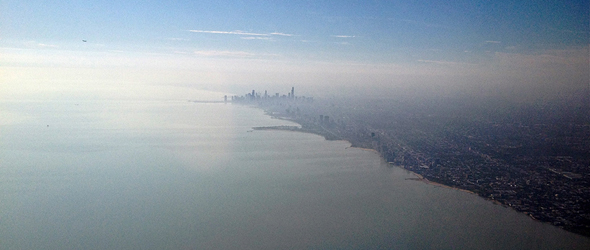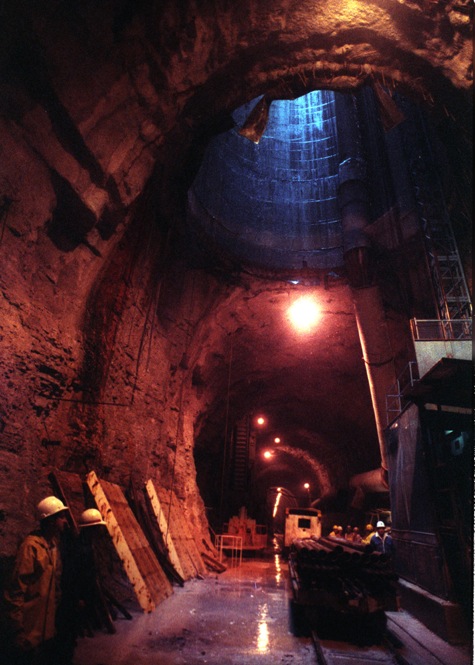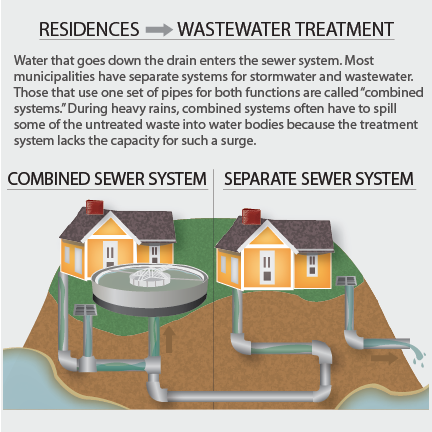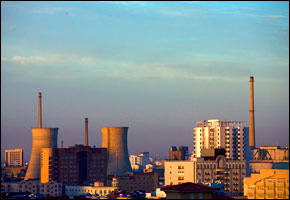Chicago’s $7 Billion Plan to Fix Crumbling Infrastructure
From expanding its largest airport to replacing century-old water pipes, Chicago introduces an ambitious construction plan that will be partly financed with public-private partnerships.

By Nadya Ivanova
Circle of Blue
CHICAGO, Illinois — Chicago is embarking on a sweeping $US 7 billion plan to transform the city’s aging infrastructure, including a $US 1.4 billion investment in water and sewer projects, Chicago Mayor Rahm Emanuel announced Thursday.
The program, slated to be one of the largest infrastructure investments in Chicago’s history, will touch “nearly every aspect of the city’s infrastructure network” — from its largest airport to streets, schools, community colleges, parks, the water system, and the commuter rail stations — creating more than 30,000 jobs over the next three years, according to the City of Chicago.
Such expensive proposals have become largely unpopular across the United States as debt, austerity, and disinvestment are overwhelming the political debate in most states, and as lawmakers in Washington, D.C., are battling over what to do about the federal government’s $US 1.2 trillion deficit. While the effects of America’s aging and eroding public infrastructure are readily apparent, how to fix it is usually not.
– Rahm Emanuel
Mayor of Chicago
Since taking office in 2011, Emanuel himself has made deep cuts to his administration’s day-to-day operational budget. But even as he acknowledged that the new infrastructure investment plan is bold, he insisted that Chicago — the nation’s third-biggest city — needs major infrastructure changes.
“We can’t be satisfied with solutions that are too small for Chicago’s ambitions. We can’t allow dysfunction, whether in Washington or Springfield, to delay our economic development,” he said in a speech announcing the program.
“Our plans are comprehensive, because our needs are comprehensive — because no city in America relies on its infrastructure more than Chicago,” Emanuel added. “By neglecting to invest in our infrastructure for nearly four decades, we have allowed Chicago’s foundations to decay and our strengths to decline. We know that, as long as our city rests on a 20th century foundation, we won’t be able to compete in a 21st century economy.”
Needed Improvements Start Right Away
As part of the program, Chicago will spend about $US 1.4 billion to fix its water system, a quarter of which is more than 100 years old. Last year, there were more than 3,800 pipe breaks in Chicago, costing the city tens of millions of dollars (it takes between $US 1 million and $US 1.5 million to repair 1.6 kilometers, or one mile, of sewers or water pipes). Chicago’s water and sewer budgets have incurred debts lately from borrowing for previous infrastructure improvements.
– Josh Ellis
Metropolitan Planning Council
The new planned improvements include replacing 1,450 kilometers (900 miles) of century-old water pipes, repairing 1,200 kilometers (750 miles) of sewer lines, reconstructing 160,000 catch-basins, and modernizing Chicago’s water filtration plants. The fixes could save an estimated 645 million cubic meters (170 billion gallons) of water by 2020, or close to all the water that Chicago households consume in two years, according to Emanuel.
In the first stage of the proposed plan, Chicago aims to rebuild 112 kilometers (70 miles) of water mains in 2012. The city plans to spend about $US 350 million on the water system and sewers in 2012, or $US 130 million more than in 2011.
It will also complete two new boathouses on the Chicago River this year and build two more in 2013.
“Our biggest water challenges are leaks; that’s what we have,” said Josh Ellis, program director at the Metropolitan Planning Council, a group of business and civic leaders that work to promote and implement planning and development policies in Chicago. “The replacing of 25 percent of the city’s pipes is not incremental change, it’s a very significant change.”

“If the city fast-tracks these infrastructure repairs in the next 10 years, then Chicago will be well ahead of other cities in the United States,” Ellis told Circle of Blue.
Storms and Floods Could Be Chicago’s Big Problem
Less robust, he said, are Chicago’s efforts to control the routine sewer overflows that often discharge a mix of sewage and storm water to Lake Michigan and the Chicago River. These are likely to become more frequent, as climate change intensifies storms and floods.
The latest infrastructure plan will address mostly the local sewers, which are the responsibility of the City of Chicago. The regional sewers are managed by the Metropolitan Water Reclamation District of the Greater Chicago (MWRDGC). Solving the region’s combined sewer overflow needs therefore will require that the city and MWRDGC work together.
In December of last year, federal and state authorities brokered a legal settlement that finally put a timetable on the completion of the Deep Tunnel, the Chicago region’s massive flood- and pollution-control project, which has been in the making for almost 40 years.
But, even as state agencies work on large-scale engineering projects, more and more experts acknowledge the need for small-scale “green infrastructure” projects that will allow storm runoff to seep into the ground, rather than drain into sewers.
“The challenge with storm water is that most of it falls on private property, not on public property,” said Ellis, who is leading one such project in Chicago’s Logan Square neighborhood. “The bigger challenge for the city is how to get its residents to retrofit their properties to reduce the pressure on public infrastructure.”
The Type of City Our Children Will Inherit
Among other major public infrastructure projects in the recently announced plan, Chicago will invest $US 1.4 billion over the next three years to open two new runways by 2015 at Chicago’s O’Hare International Airport, one of the busiest in the world. The city will also renovate, repair, or rebuild more than 100 train stations and acquire new land for parks and playgrounds, as well as invest in infrastructure in Chicago public schools and community colleges.

“The decisions we make in the next two to three years will determine what Chicago will look like in the next 20 to 30 years — the type of city our children will inherit,” Emanuel said.
The investments, according to the City of Chicago, will not require increases in taxes. Many of the projects will be paid for through reforms, efficiencies, cuts in central offices, and direct user fees, according to the official statement, though details about the scope of these changes are yet to be revealed.
At the beginning of 2012, the Chicago administration increased the city’s water rates — which were already some of the lowest in the U.S. — by 25 percent to $US 2.5 per 3.8 cubic meters (1,000 gallons), to bring Chicago in line with national averages and accelerate repair work.
Some of the financing for the sweeping plan will also come from the newly created public-private Chicago Infrastructure Trust, which was announced earlier this month by Emanuel and former president Bill Clinton. The fund, a non-profit corporation, will pool resources and expertise from private-sector lenders, investing in a wide range of public infrastructure projects.
The trust’s first initiative will finance an energy efficiency project — in line with Chicago’s climate adaptation action plan — to reduce energy consumption in city-owned buildings by 25 percent over the next three years.
While fairly common throughout the world and at the state level in the United States, a public-private partnership trust is new for a U.S. city and is especially likely to raise eyebrows in Chicago, where previous administrations were often criticized for signing privatization deals that led to the selling off of city assets. The current mayor has gone to great lengths to separate the trust from his predecessor’s selling of public assets and has insisted that the process would be transparent.
, a Bulgaria native, is a Chicago-based reporter for Circle of Blue. She co-writes The Stream, a daily digest of international water news trends.
Interests: Europe, China, Environmental Policy, International Security.





Trackbacks & Pingbacks
[…] too,” she said.Emanuel set out to address the city’s aging infrastructure with a $7 billion infrastructure plan launched in 2012. Experts say that it’s hard to evaluate the success of the projects from last […]
Leave a Reply
Want to join the discussion?Feel free to contribute!